|

|
| Vol 7|No3|February|2011 |
|
Please feel free to e-mail this article to a friend, a principal, a parent, a colleague, a teacher librarian, a college professor, a poet, a magician, a vendor, an artist, a juggler, a student, a news reporter or anyone you think might enjoy it. Other transmissions and duplications not permitted. (See copyright statement below).
It's a Mad Tea Party!
Questioning Reform Myths, Fads and Gimmicks
By Jamie McKenzie
About Author © 2010, all rights reserved
It is a mad tea party. Truly crazy.
Everyone is suddenly an expert in school change. Oprah. Bill Gates. Your next door neighbor. Their 13 year old daughter.
Imagine hiring a computer programmer to do your open heart surgery! Professional educators have been thrust aside as celebrities and politicos with no training, knowledge or background in education wade in with hip boots, all quite sure that they know how to fix things.
"We just need some free market competition!" they chant in chorus. "If you run schools like we venture capitalists, operators of hedge funds and banks . . . "
"Test kids, fire the bad teachers, get rid of the bad principals, open charter schools, kill the unions and close failing schools!"
It is a sad day when politicians of both the Left and the Right embrace simple-minded solutions to complex problems. It is fashionable these days in several countries to make excessive use of test scores and gimmicks borrowed from the corporate world to try to improve schools.
We have a host of leaders eager to drink the charter school Kool-Aid, bash public schools and ignore the root causes of school failures.
On March 1 we heard both the Secretary of Education and Bill Gates make the absurd suggestion that we improve schooling by assigning more students and larger class sizes to the best teachers.
Note Leonie Haimson's article in the Huffington Post — "Arne Duncan and Bill Gates -- Dumb and Dumber"
|
When policy makers advance school change strategies that are unproven and unhealthy for children, educators must speak out clearly to debunk the false prophets and their Kool-Aid as suggested in the article accompanying this one, "Debunking False Prophets."

The current approach to school reform and improvement is so far removed from the realities of making healthy and enduring improvement that it reminds one of the Mad Tea Party from
Alice in Wonderland.
Madness
Folly
Foolishness
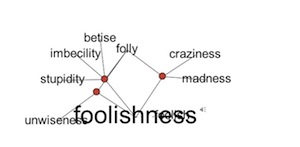
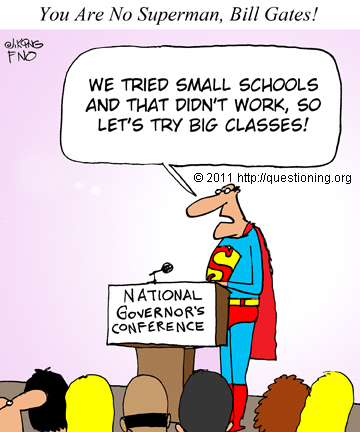
|
|
|
These change strategies are not only simple-minded; they are ill-fated, destructive and wrong. If the media were doing their proper job of debunking the myths, as the Washington Post did recently when reporting discrepancies discovered in Michelle Rhee's resume, citizens would find it easier to weigh the value of the gimmicks being proposed.
In a February 10, 2011 article, the Washington Post reported that D.C. schools chancellor Michelle A. Rhee — darling of the Get Tough with Teachers Movement — "Faces renewed scrutiny over depiction of students' progress when she taught."
According to this article, Rhee made a claim of success in her resumé while applying for the D.C. job that does not stand up to scrutiny:
- At issue is a line in Rhee's resume from that year that described her record at Harlem Park Elementary School: "Over a two-year period, moved students scoring on average at the 13th percentile on national standardized tests to 90 percent of students scoring at the 90th percentile or higher."
On Wednesday evening, Rhee said she would revise that wording if she could. "If I were to put my resume forward again, would I say 'significant' gains?" Rhee said. "Absolutely."
G.F. Brandenburg, a former D.C. teacher has provided the debunking of Rhee's claims on his blog. "The Rhee Miracle Examined Again – By Cohort"
How ironic that a national leader pushing for "value added" as a way of judging teachers and improving schools invented a way of adding value to her resume and her record that she cannot validate or verify!
|
| Both the Bush and Obama administrations have embraced reform strategies that are wrong-minded and damaging. Adding to the popular confusion is testimony from celebrities like Oprah and business leaders like Bill Gates who have little understanding of schools or schooling but plenty of opinions on what might work.
For a well reasoned review of Bill Gates' lack of understanding of schools, consider Diane Ravitch's article in Forbes: "Bill Gates And His Silver Bullet." She lists a number of his failures such as his small schools venture that wasted millions of dollars on a simple-minded idea that was not bolstered by sufficient attention to sound educational practice.
Unfortunately, political leaders and celebrities gain unwarranted attention in the media with their gimmicks, myths and strategies, aided and abetted by propaganda films like Waiting for Superman reviewed in this issue and reviewed by Diane Ravitch in the New York Review of Books "The Myth of Charter Schools."
Most of this article was written before I became aware of the Ravitch critique, so I was encouraged to see that other veteran educators would identify some of the same ill-conceived notions as those listed below. The word "myth" is especially appropriate.
Myth seems innocent enough until you take a look at related words such as story, illusion and fallacy. Thesaurus.com lists the following related words . . .
- apparition, bubble, chimera, confusion, daydream, deception, delusion, deja vu, error, fallacy, false impression, fancy, fantasy, figment of imagination, fool's paradise, ghost, hallucination, head trip, hocus-pocus, idolism, ignus fatuus, image, invention, make-believe, mirage, misapprehension, misbelief, misconception, misimpression, mockery, myth , optical illusion, paramnesia, phantasm, pipe dream, rainbow*, seeming, semblance, trip*, virtual reality

Many politicians in countries like the USA and Australia have no more understanding of schools than Alice in Wonderland, the Madhatter or the March Hare.
Their tampering is a serious assault on sound educational practice, the consequences of which are likely to be felt for decades as healthy improvement strategies are shoved aide in favor of damaging strategies.
Many politicians avoid any mention of social causes or any suggestions about parental responsibility. Even though a major factor undermining student success is the onslaught of media from Bill Gates and his corporate friends, politicians leave these players and this problem unmentioned.
In The New York Times on November 21 2011, Matt Richtel reports in "Growing Up Digital, Wired for Distraction" that "Students have always faced distractions and time-wasters. But computers and cell phones, and the constant stream of stimuli they offer, pose a profound new challenge to focusing and learning."
The data available from Generation M2: Media in the Lives of 8- to 18-Year-Olds proves that parents are a very big part of the school failure picture as their children are devoting far more time to media and entertainment than schoolwork.
- Eight- to eighteen-year-olds spend more time with media than in any other activity besides (maybe) sleeping—an average of more than 7 1/2 hours a day, seven days a week. The TV shows they watch, video games they play, songs they listen to, books they read and websites they visit are an enormous part of their lives, offering a constant stream of messages about families, peers, relationships, gender roles, sex, violence, food, values, clothes, and an abundance of other topics too long to list.
Understanding the role of media in young people’s lives is essential for those concerned about promoting the healthy development of children and adolescents, including parents, pediatricians, policymakers, children’s advocates, educators, and public health groups.
- From page 1 of the Introduction
This issue is hardly ever mentioned by these so-called reformers.
|
|
Currently Popular but Mistaken Reform Myths
|
Myth #1 — Superman knows something about schools and schooling.

© from http://www.istockphoto.com
The rapid embrace of Waiting for Superman by celebrities like Bill Gates and Oprah Winfrey is typical of our celebrity culture — one that confuses notoriety with capacity. Wishful thinking and action heroes have very little to offer when it comes to elevating the school performance of children and schools. It is difficult work that requires craft, skill, professional development and experience. It would also help if working families were paid a living wage, actually had jobs and could provide reasonable living conditions for their children.
|
Snake oil sales have been brisk for centuries.
When problems become challenging and frustrating, the general public sometimes seems quick to buy simple solutions, silver bullets and action heroes. Clark Joseph Kent, otherwise known as Superman, may have been good at journalism and fighting crime in comic strips, but he really has little to offer schools or teachers when they try to help an undisciplined child learn self control or a non-reader conquer reading.
|
|
 Myth #2 — Charter schools are better than regular schools. Myth #2 — Charter schools are better than regular schools.
Research on charter schools conducted by independent groups shows they produce mixed results. They bring no guarantee of success. There are some good ones, many mediocre charter schools and some that have failed students and parents badly. A parent and child can win the lottery but may lose the game.
© from http://www.istockphoto.com
- . . . a national study of charter schools by Stanford economist Margaret Raymond . . . Known as the CREDO study (PDF), it evaluated student progress on math tests in half the nation’s five thousand charter schools and concluded that 17 percent were superior to a matched traditional public school; 37 percent were worse than the public school; and the remaining 46 percent had academic gains no different from that of a similar public school. The proportion of charters that get amazing results is far smaller than 17 percent.
-
- "The Myth of Charter Schools"
The New York Review of Books — November 11, 2010
Diane Ravitch
The National Education Policy Center recently reported that charter schools in New York City were quite a mixed bag.
- On average, charters are not outperforming traditional public schools in the city, though city charters serve far fewer students classified as English Learners or as very poor. The authors say their findings may or may not be transferable to other settings across the country. The wealth and philanthropic culture of New York City is unique, and the city is much larger and more racially and socioeconomically diverse than most, creating greater opportunities for cream-skimming, segregation, and neighborhood selection. Report — "Adding Up The Spending: Fiscal Disparities and Philanthropy Among New York City Charter Schools"
How could this be true?
Many charter schools are started by usually well intended folks who often know little about sound educational strategies. They often count on experimentation as a powerful weapon against poor performance. Unfortunately, experimentation is a poor substitute for experience and skill. Charter schools sometimes compound this mistake by hiring mostly young, inexperienced and poorly prepared teachers who cost little in dollars but much in performance.
In some cases, those who start charter schools are not well intended and have been indulged in fraudulent, harmful activities. Note "Closure of California Charter Academy (CCA)" and "Officials to pursue school operators in court."
Recent reports from The School Choice Demonstration Project (SCDP) regarding results of charter schools in Milwaukee are not impressive. Despite the bold promises and claims of advocates, these efforts have not produced the scores and learning that was predicted. The same group made the following comment about students participating in the Washington, DC voucher program:
- No achievement impacts were observed for five other subgroups of students, including those who entered the Program with relative academic disadvantage. Subgroups of students who applied from SINI schools (designated by Congress as the highest priority group for the Program) or were in the lower third of the test score distribution among applicants did not demonstrate significant impacts on reading test scores if they were offered or used a scholarship. In addition, male students, those entering high school grades upon application, and those in application cohort 2 showed no significant impacts in either reading or math after 3 years.
When comparing charter schools with regular public schools, it is important to compare apples with apples. If all the parents and children in one school have made a special effort to sign up for a school and its program, they likely bring to schooling some attitudes that are likely to improve the chances for learning. Those who make no such effort do not make a valid control group to assess results. Even when such schools start with many advantages, they may not score well because their leaders simply do not know what they are doing and have substituted enthusiasm and passion for capacity and craft.
Recent examples of charter schools in New York City that were forced to close or suffered dramatic problems:
Should these mixed results come as a surprise?
In 2006, a report By Diana Jean Schemo in the New York Times.
August 23, 2006
"Study of Test Scores Finds Charter Schools Lagging "
WASHINGTON, Aug. 22 — Fourth graders in traditional public schools did significantly better in reading and math than comparable children attending charter schools, according to a report released on Tuesday by the Federal Education Department.
Do any of the leaders pushing charter schools bother to read these studies?
"Don't confuse my mind with facts!"
Unhappy with the CREDO study results, New York City asked the Stanford team to take a new look just at that city's results. The second report was kinder to New York's charter schools, yet the author admitted that the methodology was quite different in the second study:
- Raymond said the group’s study did not take into account whether charter schools have smaller class sizes, more instructional time, or significantly different student populations. She also noted that because the study focuses on schools with data from state tests, newly opened schools where students are too young to have been tested were not included.
The NYC report confessed that the methodology of this second report was different from the first, a confession that is usually overlooked and not mentioned by charter school proponents:
- The test for New York City schools was slightly different than the test employed in CREDO’s earlier national study. Because all the NYC schools are drawn from the same education market, there was no need to control for market differences across all the schools, as was the case in the earlier national analysis. Instead, it sufficed to use simple t-tests of each pair of schools; that is, that charter school performance against the performance of its associated comparison group. The student learning gains were averaged for each school and then compared for statistical differences.
It should be noted that this second study found positive results mainly for students who were not in poverty:
- The results for students in poverty however, only show a statistical positive impact in reading and no significant difference in math as compared to their counterparts in traditional public schools. Special Education students and English Language Learner students in charter schools in New York City receive no significant benefit or loss from charter school attendance compared to their counterparts in traditional public schools in reading and math.
When I contacted the author, Dr. Raymond, to obtain the actual data used to compare the schools, she was not able to produce or share it. Her study may have found through t-tests what is called "statistical significance" but that is not the same as finding a significant difference in scores in the real world sense. In common speech, "statistical significance" merely means there was a noticeable difference that was not a simple matter of chance. Without seeing the data, we cannot tell if there were big differences or small differences in scores and we cannot control for the fact that the charter schools had far fewer students classified as English Learners or as very poor. Her report does not share the actual t-test scores for each building pair. Nor does it report the average student learning gains for each building that were used to calculate the t-tests. Hard to assess the conclusions when the data used to calculate them are hidden from view.
According to the National Education Policy Center study mentioned earlier, charter schools in NYC generally attract far fewer free lunch students — a factor that might explain, in itself "statistical significance" between schools.
- The percentage of children eligible for free lunch attending NYC charter elementary schools—which include most of the charter schools, is 11 percentage points less than the percentage of free-lunch-eligible children attending non-charter public elementary schools. In other words, charter schools tend to serve a smaller portion of the “desperate poor” than do traditional public schools.
-
- FISCAL DISPARITIES AND PHILANTHROPY AMONG NEW YORK CITY CHARTER SCHOOLS (PDF) (January, 2011)
The research assessing the value of charter schools is a mixed bag, just as the schools themselves are a mixed bag. When carefully reviewed, it is difficult to build a convincing case that charter schools are a reliable solution to our challenges.
|
Myth #3 — Teacher unions are the real enemy and cause of poor performance.

© from http://www.istockphoto.com
Opponents of teacher tenure usually misrepresent the due process protections provided and claim that teachers are guaranteed a job for life. The level of protection varies from state to state and district to district, but these critics almost always pick the worst cases and falsely generalize from those to all teachers and all districts.
For an example of a distorted and abusive management practice that should be challenged by teacher unions, read about the value added absurdities that damage good teachers and their careers in New York City, "Evaluating New York Teachers, Perhaps the Numbers Do Lie" as reported by Michael Winerip in the March 7 2011 New York Times.
|
Many teacher unions work quite constructively to support student learning and effective teaching. While some local chapters in some school districts take a negative stance on important change efforts, this is not the case in all school districts.
Critics of teacher unions often dismiss their legitimate role in protecting teachers against abusive and exploitative management practices. Some corporate managers who have lately been reducing employee benefits and job security would love to do the same to teachers in some cases.
|
Having served as both a union member and a member of management, I have seen teacher unions exercising a valuable and constructive voice in school decision-making. They have pushed for meaningful and rich staff development as well as good class size and other resources. I have also seen them operate at times in ways that can block school improvement. It is a pattern that varies considerably from district to district.
While it may be popular to demonize both teachers and their unions, it is not at all constructive or fitting. The effort should be to harness the energy, the experience and the resources of unions to assist with the capacity building that will pay the greatest dividends in student learning. Lurking behind the attacks on union is the desire to replace expensive older teachers with cheap young teachers — thereby placing the budget ahead of quality.
|
Myth #4 — Bill Gates and Oprah Winfrey Know How to Fix Schools
Some celebrities confuse their success in one field with a universal sense of rectitude and wisdom — usually called arrogance. Neither Bill nor Oprah have the qualifications to be advising the nation on how to improve the results of schools, but their lack of expertise does not slow them down. They are quick to offer solutions that are not substantiated by research, and Bill Gates is on record for wanting to replace human teachers with machines (Speech by Gates at National Educational Computing Conference in June of 1997 in Seattle). The track record of his foundation in making educational change is quite poor, as his small schools initiative wrecked havoc across the land. Just because you're rich and famous doesn't mean you know how to improve schools. Grandiosity can often blind one to the wreckage caused when throwing around one's financial weight.
In his own words . . .
- In the first four years of our work with new, small schools, most of the schools had achievement scores below district averages on reading and math assessments. In one set of schools we supported, graduation rates were no better than the statewide average, and reading and math scores were consistently below the average. The percentage of students attending college the year after graduating high school was up only 2.5 percentage points after five years. Simply breaking up existing schools into smaller units often did not generate the gains we were hoping for.
It is also worth noting that the school performance of students is currently undermined by many of the products and the digital distractions that Bill Gates and his companies have fostered upon the society, but the Gates Foundation is unlikely to address these negative influences in their school improvement efforts.
As mentioned earlier, the data available from Generation M2: Media in the Lives of 8- to 18-Year-Olds shows that children are devoting far more time to media and entertainment than schoolwork. It would help if Gates devoted his billions to convincing young ones to turn off his products unless used for homework. In recent studies of projects that gave laptops to disadvantaged students to use at home with the hopes of improving their academic success, the performance of students in school actually declined in all three studies as students found the laptops and Internet access distracting and diversionary rather than enriching. ( "Computers at Home: Educational Hope vs. Teenage Reality" by Randall Stross — July 10, 2010 in the New York Times.)
There is little evidence that Gates has grown in wisdom regarding school improvement as he surfaced this week with another absurd proposal — that we save money while improving learning by assigning more students and larger class sizes to the best teachers.
Note Leonie Haimson's article in the Huffington Post — "Arne Duncan and Bill Gates -- Dumb and Dumber"
|
Myth #5 — Bad teachers cannot be fired.
 I hear and read this claim repeatedly on TV programs and in magazines like the New Yorker's article on Rubber Rooms in NYC, but four decades of working in schools have shown me that firing teachers is possible when their performance is properly documented and they have been given a good chance to modify their performance. As Diane Ravitch has commented, tenure does not mean immunity. Tenure requires that disciplinary efforts follow due process. Union contracts vary from district to district and are more of a barrier to change in some places than others, but opponents paint all unions with a broad brush and distort the truth. I hear and read this claim repeatedly on TV programs and in magazines like the New Yorker's article on Rubber Rooms in NYC, but four decades of working in schools have shown me that firing teachers is possible when their performance is properly documented and they have been given a good chance to modify their performance. As Diane Ravitch has commented, tenure does not mean immunity. Tenure requires that disciplinary efforts follow due process. Union contracts vary from district to district and are more of a barrier to change in some places than others, but opponents paint all unions with a broad brush and distort the truth.
Most teachers improve when confronted with negative ratings and offered assistance, but those who make little or no improvement can be fired before they reach tenure, and tenured teachers can be forced out without going through formal proceedings in many districts.
A teachers' union will often urge them to move along when the administration has done a thorough job of documenting and supporting. While this documentation is challenging, it is a fair process that protects employees from wrongful firing as well as arbitrary and capricious managers. Critics of school unions make it seem like teachers are the only ones protected in this way but corporations that fire people without just cause and due process may also be punished for such mistreatment. Note the lawsuit against Welch's Food Inc.
- Welch's food pays $14k over wrongful firing
January 11, 2011
LAWTON, Mich. (NEWSCHANNEL 3) – Welch's Food Inc. violated the Family Medical Leave Act, and now they are paying for it.
Welch's is shelling out more than $14,000 in back wages after wrongfully firing an employee.
The employee was let go after she asked for medical leave for a health condition, something covered under the FMLA.
The FMLA provides protection to workers who have serious illness or injury and gives them up to 12 work weeks of leave without risk of losing their job.
-
Not all school administrators are willing to take the risk of confronting weak teachers with their poor teaching performance and not all know how to support teacher growth. The current fad of using test scores to determine what is called "value added" is a cheap and invalid way to assess teaching skill that does little to support growth or capacity building.
In my own career, I found that bad teachers could be removed from the classroom without resorting to the "rubber room" described in the New Yorker. More importantly, I found that good supervision could radically improve the performance of teachers. We see too little focus on the recruitment and grooming of new administrators to provide this kind of supervision and even see a movement to recruit leaders from outside the profession to manage schools — leaders who have not the faintest notion of how to help build a good lesson, let alone build a teacher's capacity.
I have no doubt that working to improve teaching is a difficult task and one that is more difficult in some districts than in others, but the national discussion of reform rarely mentions anything but the worst cases and then generalizes to the whole based on those bad situations.
|
Myth #6 — Testing kids all the time on just two indicators (math and reading) and judging teachers on such test scores leads to better school performance.
Despite a decade of extreme and narrow testing, American students have shown very little progress on the things being tested, and there is no credible evidence that currently popular "value-added" approaches lead to improved student performance over time. Proponents of such reform strategies are generally unable to produce persuasive and valid evidence to support their focus on test scores as a measure of teacher effectiveness. Both President Bush and President Obama have failed the AYP measures applied to schools by No Child Left Behind.
According to recently released results from the NAEP Science tests, few American students reach the proficient level in science.
- Highlights of the national results show that 34 percent of fourth-graders, 30 percent of eighth-graders, and 21 percent of twelfth-graders performed at or above the Proficient level, demonstrating competency over challenging subject matter. Seventy-two percent of fourth-graders, 63 percent of eighth-graders, and 60 percent of twelfth-graders performed at or above the Basic level in science in 2009, demonstrating partial mastery of the knowledge and skills fundamental for proficient work in the subject.
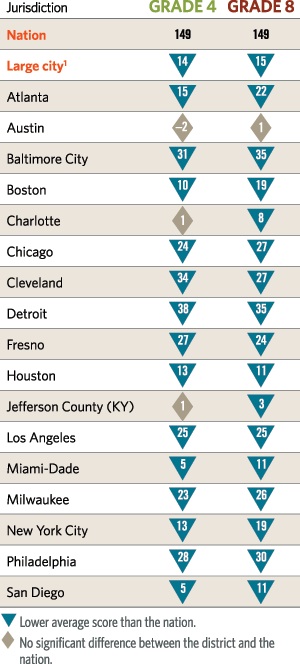 These poor results are even worse in cities where the full brunt of No Child Left Behind has inspired a single-minded focus on math and reading. These poor results are even worse in cities where the full brunt of No Child Left Behind has inspired a single-minded focus on math and reading.
Observers have been warning for quite some time now that narrowly focused testing would do damage. When schools give students double and triple doses of math and reading in order to survive NCLB's AYP provisions (Acceptable Yearly Progress), they usually skip social studies, science and almost anything that might get in the way of scoring well on those two other indicators.
March 26, 2006
By Sam Dillon in the New York Times.
"Schools Cut Back Subjects to Push Reading and Math"
Thousands of schools across the nation are responding to the reading and math testing requirements laid out in No Child Left Behind, President Bush's signature education law, by reducing class time spent on other subjects and, for some low-proficiency students, eliminating it.
Schools from Vermont to California are increasing — in some cases tripling — the class time that low-proficiency students spend on reading and math, mainly because the federal law, signed in 2002, requires annual exams only in those subjects and punishes schools that fall short of rising benchmarks.
In addition to the issue of narrow focus, we see states fudging results by assessing students with tests that are absurdly easy. Politicians and leaders are so eager to impress the voters that they engage in what amounts to fraudulent reform.
"State’s Exams Became Easier to Pass, Education Officials Say" By JENNIFER MEDINA
Published in the New York Times: July 19, 2010
- New York State education officials acknowledged on Monday that their standardized exams had become easier to pass over the last four years and said they would recalibrate the scoring for tests taken this spring, which is almost certain to mean thousands more students will fail.
While scores spiked significantly across the state at every grade level, there were no similar gains on other measurements, including national exams, they said.
“The only possible conclusion is that something strange has happened to our test,” David M. Steiner, the education commissioner, said during a Board of Regents meeting in Albany. “The word ‘proficient’ should tell you something, and right now that is not the case on our state tests.”
Large jumps in the passing rates, which Mayor Michael R. Bloomberg trumpeted in his re-election campaign last year, led to criticism that the tests had become too easy.
|
Myth #7 — Playing musical teachers, musical principals and closing poor schools improves the learning of the children who were in those schools.
In cities like New York City, Washington, D.C. and Chicago it has been fashionable to close down poorly performing schools and move everybody elsewhere - principals, teachers and students. In none of these cities is it possible to demonstrate that moving folks around has improved performance. It has not worked so far and the strategy would require a huge number of unemployed excellent teachers and principals to make it work, as the firing of weak performers would lead to such turnover that we would need hundreds of thousands of teachers and tens of thousands of skilled principals just waiting in the wings for a new job. Chances are that weak people will be replaced by the young and the inexperienced.
"U.S. Plan to Replace Principals Hits Snag: Who Will Step In?"
By SAM DILLON in the New York Times
- Principals of many failing schools, once expected to be removed as part of a national effort, stay because there are not enough qualified people to take over.
- In Chicago, federal money is financing an overhaul of Phillips Academy High School. Mr. Cawley’s nonprofit trained Phillips’s new principal, Terrance Little, by having him work alongside mentor principals experienced at school makeovers.
“If we’re talking about turning around 700 schools, I don’t think you can find 700 principals who are capable of taking on the challenge of this work,” Mr. Little said. “If you could, why would we have this many failing schools?”
According to a report from Catalyst Chicago — an editorially independent newsmagazine published by the Community Renewal Society — there is little evidence to support the claims of progress made for such strategies in Chicago. "Decoding the district's progress report for 2008" by John Myers, Wednesday, January 7, 2009 challenges the spin and hype.
- Chicago Public Schools put on its best face in 2008: Another Year of Strong Progress for Chicago’s Students – the district’s self-assessment of last year’s accomplishments and test score gains. But the rosy numbers mask a troubling reality, including decidedly mixed results on test scores at the showcase turnaround schools. On one measure – first-day attendance – the district is being disingenuous.
Centerpiece strategies such as the closing of failed schools, the firing of failed principals, the opening of charter schools and the offering of cash incentives for good scores are old ideas — unproven gimmicks that have been around since the 1970s, and while the rhetoric is full of passion and conviction, those beliefs are unsubstantiated.
Results on reading from the "Nations Report Card for 2009 — Reading 2009 - TRIAL URBAN DISTRICT ASSESSMENT" are disappointing. Neither Chicago nor Washington, DC showed gains at the 8th grade level from 2002, casting doubt on the impacts claimed by Secretary Duncan or former Chancellor Rhee. Some gains were made at Grade 4 in those two cities, but in the case of DC, these gains only show up when results from charter schools (whose overall scores went down) are excluded. The gains in both cities for that grade are relatively small in contrast with the claims of their dramatic former leaders.
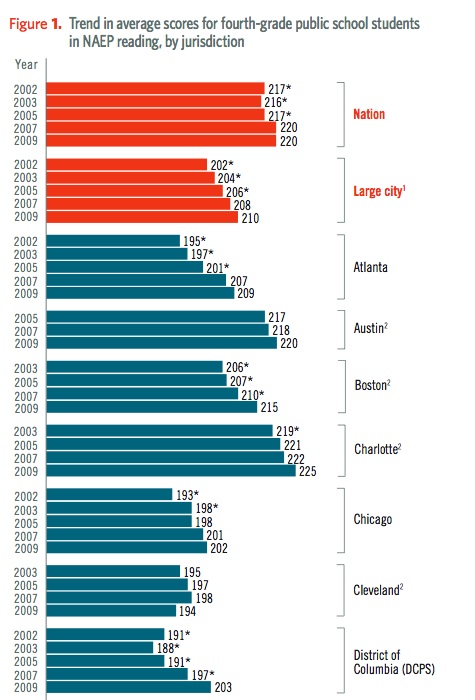
- "At grade 4, average reading scores increased since 2007 in 4 of the 11 participating districts, although there were no significant changes in the scores for fourth-graders in the nation or large cities overall. Scores were higher in 2009 than in 2002 for five of the six districts that participated in both years, along with increases for both the nation and large cities over the same period.
At grade 8, average reading scores for the nation and large cities were higher in 2009 than in 2007, with 2 of the 11 participating districts (Atlanta and Los Angeles) showing gains."
|
Myth #8 — Teaching performance is the sole factor governing the success or failure of students.
The success of students depends upon a complex array of at least several dozen inputs. 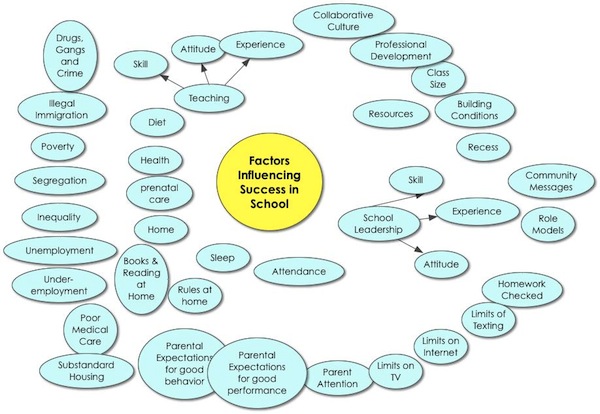
Research shows that students read better if their parents read to them nightly. Research shows that students read better if there are books in the home. Research shows that students read better if they get enough sleep. Research shows that students read better if they have a home and a roof over their heads. Research shows that students read better if they can settle down and live in one neighborhood for several years at a time. Research shows that students read better if they do not make excessive use of TV and entertainment media at home. Research shows that students read better if their teacher is an effective teacher of reading skills. Research shows that students read better if their teacher has been provided a rich background in effective strategies for teaching reading.
Evidence: "Reading Proficiency and Home Support for Literacy" Vol. 2, No. 1, NCES 96-814 and "Turning the Page: Refocusing Massachusetts for Reading Success." For research on the importance of skillful teaching, SEDL is a private, nonprofit education research, development, and dissemination (RD&D) corporation based in Austin, Texas that offers some excellent resources — "Building Reading Proficiency at the Secondary Level: A Guide to Resources."
It is simple minded to focus all school improvement efforts on teacher accountability. Parents play a critically important role in the education of children but politicians are careful to leave them alone, fearful of losing votes. A comprehensive reform effort would seek to improve all of the factors likely to contribute to school success rather than just a few. Such an effort would invest heavily in substantial courses in the teaching of reading for all teachers, for example, to enhance their skill levels. Such an effort would invest heavily in parenting classes. Such an effort would invest heavily in Head Start. Such an effort would invest heavily in full employment for parents at reasonable pay levels. Such smart parent involvement strategies might be used by regular public schools and are often characteristic of the more successful charters like the KIPP Schools:
- Some observers, such as the authors of The Charter School Dust-Up, say that KIPP's admission process self-screens for students who are both motivated and compliant, from similarly motivated and compliant—and supportive—families. Parents must commit to a required level of involvement, which rules out badly dysfunctional families.
- In addition, some KIPP schools show high attrition, especially for those students entering the schools with the lowest test scores. A 2008 study by SRI International found that although KIPP fifth-grade students who enter with below-average scores significantly outperform peers in public schools by the end of year one, "... 60 percent of students who entered fifth grade at four Bay Area KIPP schools in 2003-04 left before completing eighth grade.
-
As mentioned earlier and documented in Generation M2: Media in the Lives of 8- to 18-Year-Olds, today's students spend many hours on media and entertainment that could be devoted more productively to learning tasks — an issue that parents must address if they find the school performance slipping. Schools that manage to reduce that distraction, whether they be regular public schools or charter schools, must have the cooperation of parents to achieve such a goal.
|
Myth #9 — Good teaching is a mechanistic, factory process that can be reduced to a set of formulas and recipes that will guarantee student success.
Standardization of teaching and instruction has been the hallmark of many reform efforts pushed by both Presidents and many school districts for the past decade, starting with national reading programs required by Reading First; yet these so-called research proven approaches have not substantially improved performance of students when measured on secure national tests such as the NAEP - Note Ed Week article.
- Eighth grade reading scores have been stagnant nationally. The overall reading scores for the nation in this grade were precisely the same in 2009 as they were in 1998.
The factory model of learning does not work because children are not hamburger patties passing along an assembly line. Customization and personalization are the pathways to success, and teachers that are both skilled and experienced are most likely to win the largest gains when they are allowed to practice those strategies. A more promising approach is RTI - the response-to-intervention framework which emphasizes personalized instruction: "Calif. District Uses RTI to Boost Achievement for All."
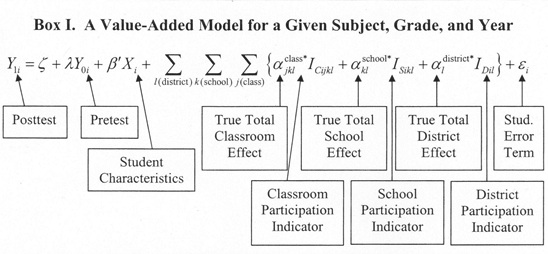
The narrow focus on student test scores as a way of judging teacher performance is a remarkably unfair and unreliable way to measure performance according to many reviews of this approach, but this lack of reliability does not stop leaders like Rhee, Gates and Duncan from sounding their enthusiastic trumpets . . .
- The Bill & Melinda Gates Foundation’s “Measures of Effective Teaching” (MET) Project seeks to validate the use of a teacher’s estimated “value-added”—computed from the year-on-year test score gains of her students—as a measure of teaching effectiveness. Using data from six school districts, the initial report examines correlations between student survey responses and value-added scores computed both from state tests and from higher-order tests of conceptual understanding. The study finds that the measures are related, but only modestly. The report interprets this as support for the use of value-added as the basis for teacher evaluations. This conclusion is unsupported, as the data in fact indicate that a teachers’ value-added for the state test is not strongly related to her effectiveness in a broader sense.
- Most notably, value-added for state assessments is correlated 0.5 or less with that for the alternative assessments, meaning that many teachers whose value-added for one test is low are in fact quite effective when judged by the other. As there is every reason to think that the problems with value-added measures apparent in the MET data would be worse in a high-stakes environment, the MET results are sobering about the value of student achievement data as a significant component of teacher evaluations.
Rothstein, J. (2011). Review of “Learning About Teaching: Initial Findings from the Measures of Effective Teaching Project.” Boulder, CO: National Education Policy Center.
|
Myth #10 — People who have never been teachers or worked in schools make good leaders to turn around failing schools and districts.
 Despite the terrible performance of the banking industry, the automobile industry and other sectors of the economy in recent years, many would-be educational reformers argue that business people like the new Chancellor in New York City can turn around failing systems simply because they are business people. Despite the terrible performance of the banking industry, the automobile industry and other sectors of the economy in recent years, many would-be educational reformers argue that business people like the new Chancellor in New York City can turn around failing systems simply because they are business people.
While this argument has been made for several decades by folks outside of education, there is no convincing research evidence showing that leaders without educational experience make effective principals or school leaders.
One of the most important roles of a principal is the supervision and improvement of instruction. For principals to perform this role, they must be capable of effective teaching themselves and understand sound pedagogy enough to diagnose and prescribe remedial action when that is needed.
|
Myth #11 — Problems with school performance are unrelated to racial segregation, economic inequalities, illegal immigration, poverty and the failure of state and national governments to address those issues.
Despite volumes of evidence linking poor school performance with poverty, segregation and other social issues, none of the so-called reformers devote attention to these causes of school difficulties. Politicians generally prefer the elimination of tenure as a platform to the elimination of poverty, unemployment and hunger. Those who push for an end to tenure are slow to approve of minimum wage increases or any government efforts related to social justice.
- Why Segregation Matters: Poverty and Educational Inequality
Authors: Gary Orfield, Chungmei Lee
Date Published: January 13, 2005
- The high level of poverty among children, together with many housing policies and practices which excludes poor people from most communities, mean that students in inner city schools face isolation not only from the white community but also from middle class schools. Minority children are far more likely than whites to grow up in persistent poverty. Since few whites have direct experience with concentrated poverty schools, it is very important to examine research about its effects.
- Socioeconomic segregation is a stubborn, multidimensional and deeply important cause of educational inequality.
|
Myth #12 — Recruitment and retention of the best and the brightest teachers is insured by strategies that focus on teacher and school bashing.
The school reformers seem tone deaf when it comes to the impact of their teacher and school bashing on the willingness of young people to consider teaching as a lifetime career choice. They also ignore the impact of these negative change strategies on skilled veterans who are highly successful in the classroom. Instead of making teaching an attractive profession, they have created a host of disincentives that will serve to extend the crisis.
While these reformers like to point to programs like Teach for America that bring bright college students into teaching without passing through normal teacher preparation programs, they rarely admit that the majority of these bright young people do not persist or endure as classroom teachers, moving on instead after a few years to more lucrative positions in banking, law or industry after having enhanced their portfolios with a few years of public service. Meanwhile, traditional sources of lifelong teaching candidates find their enthusiasm for teaching dampened by all of the negative publicity and the attacks on public schools.
|
Myth #13 — Most American public schools and most teachers are doing a terrible job.
The performance of schools and students in the U.S.A. is generally related to the affluence of the community. When you compare the performance of American students from affluent suburbs to their counterparts internationally, they do very well, but those schools and teachers rarely get any notice or any credit. Public schools are lumped together without discernment and dealt the same level of criticism whether they are failing or succeeding. Even though parents of children in public schools have generally rated their schools very favorably every year in the Gallup Poll, politicians are fond of sweeping generalizations that do not match the facts.
If politicians looked more honestly at the variations in school performance, the relationship between income, employment, race and social class would become evident and the social issues influencing schools would require their attention — a focus few of them are willing to embrace.
|
Myth #14 — There are plenty of qualified excellent teachers and principals waiting (unemployed and unassigned) to take the place of bad ones.
As mentioned earlier, the Obama/Duncan strategy of replacing weak principals with strong ones has bumped into a supply problem; there are too few principals with the skills to turn around failing schools, and most of them are already trying to work such magic in an existing school. Moving them from their current school to a new one makes little sense. This discovery should not have come as a surprise, but it is typical of these change agents to fail to anticipate the full consequences of their actions. If you launch a national strategy to replace principals, it would seem obvious to ask where you will find the new ones?
"U.S. Plan to Replace Principals Hits Snag: Who Will Step In?"
By SAM DILLON in the New York Times
- Principals of many failing schools, once expected to be removed as part of a national effort, stay because there are not enough qualified people to take over.
- “If we’re talking about turning around 700 schools, I don’t think you can find 700 principals who are capable of taking on the challenge of this work,” Mr. Little said. “If you could, why would we have this many failing schools?”
It is astonishing that nobody in Duncan's office thought of this problem before it surfaced.
It is equally astonishing that reformers keep talking about replacing bad teachers with good ones without making significant efforts to fill the pipeline with qualified recruits. They throw money at flawed programs like "Teach for America" and want to lower entry standards so that smart college grads may teach without proper training, but they do little to make teaching more attractive or rewarding. They do little to strengthen existing teacher training programs, preferring instead to criticize such programs, as Secretary Duncan has often done.
|
|
|
|
.
Copyright Policy: Materials published in The Question Mark may be duplicated in hard copy format if unchanged in format and content for educational, nonprofit school district and university use only and may also be sent from person to person by email. This copyright statement must be included. All other uses, transmissions and duplications are prohibited unless permission is granted expressly. Showing these pages remotely through frames is not permitted.
FNO Press is applying for formal copyright registration for articles.
Unauthorized abridgements are illegal.
|
|
|
|






 Myth #2 — Charter schools are better than regular schools.
Myth #2 — Charter schools are better than regular schools.
 I hear and read this claim repeatedly on TV programs and in magazines like the
I hear and read this claim repeatedly on TV programs and in magazines like the  These poor results are even worse in cities where the full brunt of No Child Left Behind has inspired a single-minded focus on math and reading.
These poor results are even worse in cities where the full brunt of No Child Left Behind has inspired a single-minded focus on math and reading.


 Despite the terrible performance of the banking industry, the automobile industry and other sectors of the economy in recent years, many would-be educational reformers argue that business people like the new Chancellor in New York City can turn around failing systems simply because they are business people.
Despite the terrible performance of the banking industry, the automobile industry and other sectors of the economy in recent years, many would-be educational reformers argue that business people like the new Chancellor in New York City can turn around failing systems simply because they are business people.